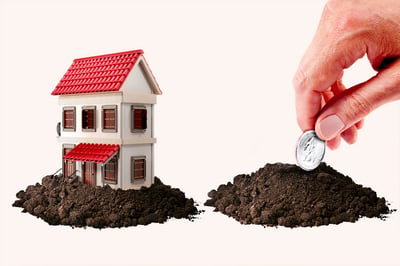 As we move into the Fall season and closer to the fourth quarter of the year, no one can deny that the real estate market has been full of surprises. Ask any expert what they thought was going to come of real estate back in March or April, and surely we’d have seen a sea of predictions spelling doom for the real estate industry as we know it.
As we move into the Fall season and closer to the fourth quarter of the year, no one can deny that the real estate market has been full of surprises. Ask any expert what they thought was going to come of real estate back in March or April, and surely we’d have seen a sea of predictions spelling doom for the real estate industry as we know it.
While there are still similar predictions being made, we have seen the real estate market truly defy expectations. Even back in December 2019, before the COVID-19 pandemic threw our way of life into turmoil, experts were predicting a real estate market crash. It wasn’t surprising — after all, the market has been long overdue for a recession.
It’s true, too, that the market slowed considerably at the beginning of the pandemic. Since, however, we’ve seen a roaring, active market through the summer. While the market is typically the hottest in the summertime and sees reduced activity in the fall (due to a want for stability as children return to school and the holiday season approaches), we’re seeing no signs of slowing.
Naturally, the buzz around real estate is a surprising bright spot in the middle of a turbulent economy and societal upheaval. Many are turning to real estate not only as an investment but as a safe haven (both in the economic sense and the literal sense) from COVID-19 fears and market impact.
However, this moment is not all that there is. For real estate investors, it’s more important than ever to choose your method of investing carefully. After all, not all sectors of real estate are seeing the same explosive growth.
3 Facts About the Present Real Estate Market
Mortgage Rates Spur Market Interest
Mortgage rates are providing a big incentive to would-be homebuyers. We’re still hitting all-time low rates as recently as the second week of September 2020 — with a 30-year fixed interest rate of 3.86 percent. As a result, homebuying has been up, not only due to pent-up demand from a slowed spring but due to the advantageous rates.
Single-Family Properties See Big Demand
We’ve covered this point a few times since the pandemic began to show its true impact on the economy and real estate market at-large. The demand for single-family homes, be they owner-occupied or rentals, is on the rise — largely due to demands for increased space between neighbors and areas with lower overall population density. This bodes well for secondary and tertiary markets as well as suburban and rural areas in general.
Be sure to check out: Secondary Markets for Long-Term Real Estate Investment Success
Lagging Supply Pushes Prices
Supply has been a problem since the Great Recession. This decade-long issue has been a major factor in rising home prices, particularly in those with high and increasing demand. Supply remains tight, even as buyers shied away from the market during the Spring. Whether homebuilding has yet to catch up or sellers are holding fast to their properties, there doesn’t seem like enough houses to go around.
Factors Influencing the Future of Real Estate
Economic Disparities
While it’s easy to diagnose real estate trends from a bird’s eye view, the truth of the matter is a bit more complex. In the United States, particular types of real estate and individuals face greater challenges in real estate than others. For example, middle and upper-class families are much more likely to have jobs that accommodate remote work. These are the people who tend to be looking to buy new homes with more space in their flight to the suburbs, either as buyers are renters.
Lower-class families, on the other hand, are more likely to hold occupations that do not allow remote working as an option. They’re also more likely to inhabit apartments and struggle to pay their rent due to a more precarious employment situation.
This disparity shows a picture of two different worlds for Americans, and it divides further when we consider different types of real estate: single-family, multifamily, and commercial. While single-family homes are seeing a surge in demand (both as rentals and owner-occupied homes), commercial real estate and multifamily properties are feeling the pains of the COVID-19 economic impact.
While many businesses struggle and their property needs shift, multifamily properties, in a similar way, are struggling to maintain residents and contend with delays in rent payments. This disparity will most likely grow — both economically among Americans and different types of real estate.
Interest Rate Trends
Home prices and mortgage rates have had a close cause-and-effect relationship over the years. According to experts, this could pose a problem in the future for homeowners relying on the appreciation of their personal residences. Interest rates can only go so low, and while they are a necessary boon in times such as these, it doesn’t mean they’ll last forever. Some believe that the slowing decline of interest rates have been a driving force behind consistently growing home values — at least in part.
A question for the future is if these rates will remain low. It’s unlikely that they will drop further in the face of another crisis, and the potential for rates to increase again could cause a slip in home values. For example, the 1980 median cost of a home was anywhere between $54,000 and $58,000 (or around $175,000, adjusted for inflation.) That year saw a mortgage rate of 13.74 percent on average.
Today’s median home price is up to $278,000.
Mortgage rates tend to have an inverse relationship with home prices, but they are not the sole factor that influences price and worth. However, with rates as low as they are now, we can only suspect a turn in the future that may impact home prices.
While we can’t be sure what the future holds for the real estate market, we do know that we can look to historical trends and rely on a model that has been building wealth for centuries.
Stay up-to-date and in-the-know about all things real estate investment.












